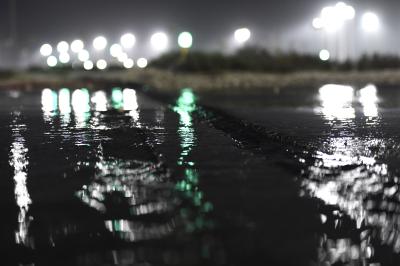Race Direction explains Qatar wet weather test
After last year’s confusion, a 30-minute ‘wet weather’ test has been arranged for the final night of the Qatar test in order to assess whether riders’ visibility is overly affected by the reflection of the floodlights, race direction has confirmed.
Mike Webb, MotoGP’s Race Director, told Crash.net the final hour of Saturday's test, which takes place in the dark, will be set aside to wet the track at the Losail International Circuit, and riders will leave pit lane together to try and replicate a wet race scenario.
After last year’s confusion, a 30-minute ‘wet weather’ test has been arranged for the final night of the Qatar test in order to assess whether riders’ visibility is overly affected by the reflection of the floodlights, race direction has confirmed.
Mike Webb, MotoGP’s Race Director, told Crash.net the final hour of Saturday's test, which takes place in the dark, will be set aside to wet the track at the Losail International Circuit, and riders will leave pit lane together to try and replicate a wet race scenario.
Should riders relay to him the glare of the floodlights is overpowering and diminishes their sight, race direction will have definitive evidence that a wet outing will never take place when dark and the floodlights at the Losail International Circuit are switched on.
Plans will then be drawn up to decide on a course of action if rain affects the first round of the MotoGP season, as it did a year ago, when qualifying had to be scrapped entirely, and the premier class race was delayed due to a light shower on the grid.
However Loris Capirossi, Dorna’s representative in race direction, conducted a similar test last year during which he followed Safety Officer Franco Uncini’s car on a road bike after the track had been soaked.
According to Webb, the three-time world champion had stated that racing under the floodlights in the rain is “completely viable.” The upcoming test will judge those conditions when 24 bikes are on track, jockeying for position and kicking up spray, rather than one.
Ultimately, the decision will be left to the riders, who will discuss the conditions after the outing, and come to a unified decision.
“It’s following all the years where it has impacted the race there – especially last year,” said Webb at last weekend’s test in Thailand. “The decision was no matter what, we had to find out if it’s viable to have bikes on a wet track under the lights or not. We have to know once and for all.
“And then we can go from there what we’re going to do if it rains. So that’s the first step. The last hour of the last day with a wet track. It’s a test only of the visibility available. It’s not about setting up, doing a lap time, or anything like that. It’s simply go out, ride around in a group and see what the visibility is like and if they can see. That’s the number one question.
“If the answer is ‘no’ then we’ll never run it in the rain. If the answer is ‘yes’ we’ll decide on what our plan is if it rains during the grand prix.
“With our new timetable for this year, that’s covered for Moto2 and Moto3. They’re running in daylight. They run in the rain in the daylight at that track. It’s just the combination of the lights and the rain that’s the problem. We have to see if we can run in those conditions or not.”
On Capirossi’s previous experience riding in Qatar in the rain, Webb revealed, “Loris rode the bike for this exact same reason we needed to know. Because it was one rider on one bike, and we were trying to simulate spray and everything with Franco in the car, kicking up some spray, and Loris riding.
“The track was wet in some places. It was a limited test and to be honest it wasn’t conclusive. I watched the videos and thought, ‘We’re not racing in the rain.’ Then what the camera showed was quite different to Loris’ experience on the bike. He said it was completely viable.
“What we want is confirmation of that, of lots of riders together in a group, with spray, on MotoGP bikes and an opinion from riders that are actually competing in a championship. It’s like a lot of safety decisions; it’ll come down to a lot of riders agreeing on it.”
On the logistics of the operation, Webb explained, “18 very large trucks filled with water wet the whole track. It’s because the session is limited to a very short time. We only want to see what the visibility is like.
“Their experience is that you can wet the whole track and have it substantially wet for the time that we require. It’s possible. It’s a big logistic exercise but they’re in a position to do it, so let’s go.”
The timetable of the first race weekend of the year has changed from previous seasons. Now the Moto3 and Moto2 races have been brought forward by two hours, meaning the MotoGP race is the only outing that will take place at night.


![Johann Zarco, LCR, Honda RC213V, 2024 San Marino MotoGP, Misano, action [Gold & Goose]](https://cdn.crash.net/styles/thumbnail/s3/2024-09/GnG_1166323_HiRes.jpg?itok=vpgrU7Q4)

![Jack Miller, KTM Factory Racing, KTM RC16, San Marino MotoGP, Misano, action [Gold & Goose]](https://cdn.crash.net/styles/thumbnail/s3/2024-09/GnG_1167624_HiRes.jpg?itok=iz7mA4EQ)


![Fabio Quartararo, Monster Energy Yamaha Racing, Yamaha M1, 2024 MotoGP, Misano Test, action [Gold & Goose]](https://cdn.crash.net/styles/thumbnail/s3/2024-09/GnG_1168928_HiRes.jpg?itok=fcYSole_)
![Toprak Razgatlioglu, ROKiT BMW Motorrad, BMW M 1000 RR, Magny-Cours, WorldSBK [Gold & Goose]](https://cdn.crash.net/styles/thumbnail/s3/2024-09/GnG_1165133_HiRes.jpg?itok=GD5SVNVG)

